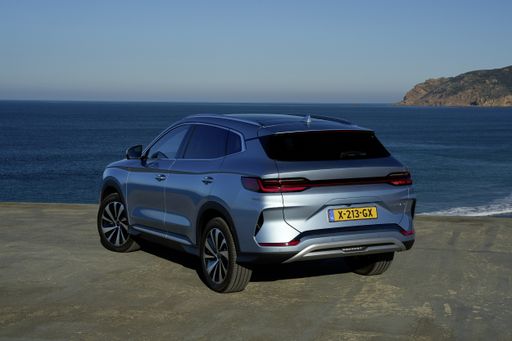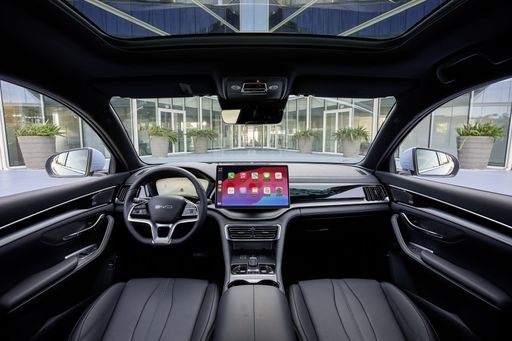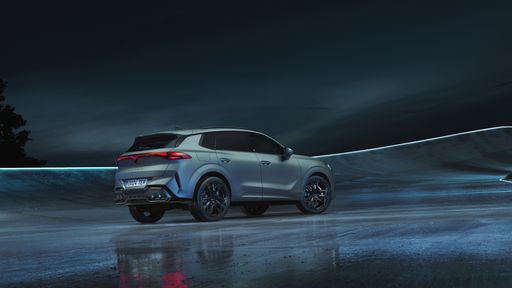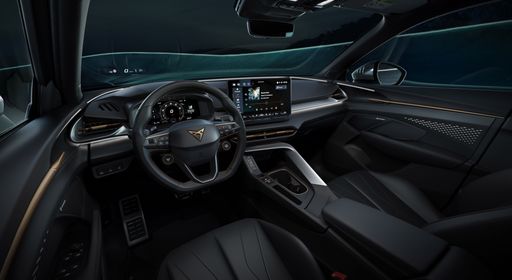In an increasingly competitive automotive landscape, the allure of electric and hybrid vehicles has captured the attention of consumers and manufacturers alike. The BYD Seal U and CUPRA Terramar are two prime examples of this trend, showcasing innovative technologies, impressive specifications, and unique design philosophies. In this comparison, we’ll explore their technical aspects, innovations, and overall capabilities.
BYD Seal U vs CUPRA Terramar – Which car suits you better?
Everyday use, family trips or long-distance drives – here’s where the differences show.
Discover whether BYD Seal U or CUPRA Terramar fits your lifestyle better.
Design and Dimensions
Both vehicles reflect modern SUV aesthetics, emphasizing sportiness combined with practicality. The BYD Seal U measures 4775 mm in length, 1890 mm in width, and stands at a height of 1670 mm. In contrast, the CUPRA Terramar is slightly smaller at 4519 mm long and 1869 mm wide, with a height of 1586 mm. With a trunk capacity of 425 to 552 liters, the Seal U offers more versatile storage options compared to the CUPRA's 450 to 540 liters, reflecting its larger build.
Powertrain and Performance
The heart of the BYD Seal U beats with several options: the electric variant delivers up to 324 HP, while the plug-in hybrid version tops out at 218 HP. Operating in both front-wheel and all-wheel-drive configurations and boasting a 0-100 km/h acceleration time of 5.9 seconds for the fastest variant, it provides a thrilling drive. The CUPRA Terramar, on the other hand, offers a choice between a petrol engine delivering 265 HP and a plug-in hybrid version with a notable brute strength of 272 HP. It also features an impressive acceleration time of just 5.3 seconds, showcasing its performance-focused engineering.
Efficiency and Range
Fuel efficiency is a significant consideration for many buyers. The BYD Seal U demonstrates outstanding performance in this area with a consumption as low as 0.9 L/100 km for its hybrid version and an electric range of up to 500 km. The CUPRA Terramar, however, features a hybrid-electric consumption rating of 0.4 L/100 km with a limited electric-only range of 120 km. The varying needs of consumers may find more appeal with the BYD's extended electric miles.
Innovative Features
Both models are equipped with advanced technology, but their focus diverges slightly. The BYD Seal U includes a range of electric-centric innovations that enhance the electric driving experience, such as efficient regenerative braking and connectivity features that optimize battery utilization. Meanwhile, the CUPRA Terramar’s tech suite emphasizes sporty performance and offers advanced driving aids, including a dual-clutch transmission for seamless gear changes.
Comfort and Interior
Inside, both vehicles comfortably seat five passengers, boasting design elements that prioritize elegance and luxury. The Seal U allows for a high-tech interior experience, featuring a large infotainment screen handling various media and navigation tasks. The CUPRA Terramar, on the other hand, leans towards a performance-oriented design, integrating sport seats and a driver-focused layout that elevates the driving experience with high-quality materials.
Conclusion: Which One to Choose?
Ultimately, the choice between the BYD Seal U and the CUPRA Terramar will depend largely on individual preferences and needs. If you seek an all-electric SUV with exceptional range and efficiency, the BYD Seal U stands out with its innovative tech and strong performance credentials. Conversely, if performance and a dynamic driving experience are paramount, the CUPRA Terramar provides thrilling acceleration and a sportier driving demeanor. Both vehicles embody the future of automotive innovation, offering distinctive features that appeal to different types of drivers.
Here’s where it gets real: The technical differences in detail
Costs and Efficiency:
Price and efficiency are often the first things buyers look at. Here it becomes clear which model has the long-term edge – whether at the pump, the plug, or in purchase price.
BYD Seal U has a minimal advantage in terms of price – it starts at 34300 £, while the CUPRA Terramar costs 36900 £. That’s a price difference of around 2597 £.
Both cars consume an average of 0.40 L per 100 km – no difference here.
As for range, the BYD Seal U performs convincingly better – achieving up to 500 km, about 380 km more than the CUPRA Terramar.
Engine and Performance:
Under the bonnet, it becomes clear which model is tuned for sportiness and which one takes the lead when you hit the accelerator.
When it comes to engine power, the BYD Seal U has a a bit edge – offering 324 HP compared to 272 HP. That’s roughly 52 HP more horsepower.
Both models accelerate almost equally fast – 5.90 s from 0 to 100 km/h.
In terms of top speed, the CUPRA Terramar performs clearly perceptible better – reaching 243 km/h, while the BYD Seal U tops out at 180 km/h. The difference is around 63 km/h.
There’s also a difference in torque: BYD Seal U pulls clearly perceptible stronger with 550 Nm compared to 400 Nm. That’s about 150 Nm difference.
Space and Everyday Use:
Whether family car or daily driver – which one offers more room, flexibility and comfort?
Both vehicles offer seating for 5 people.
In curb weight, CUPRA Terramar is somewhat lighter – 1638 kg compared to 1940 kg. The difference is around 302 kg.
In terms of boot space, the BYD Seal U offers barely noticeable more room – 552 L compared to 540 L. That’s a difference of about 12 L.
When it comes to payload, CUPRA Terramar distinct takes the win – 542 kg compared to 410 kg. That’s a difference of about 132 kg.
Who comes out on top?
Overall, the BYD Seal U shows itself to be secures victory with a clear margin and secures the title of DriveDuel Champion.
It convinces with the more balanced overall package and proves to be the more versatile choice for everyday use.
 @ BYD Auto / BYD Global Media
@ BYD Auto / BYD Global Media
BYD Seal U
BYD Seal U
The BYD Seal U presents itself as a sophisticated addition to the electric vehicle market, blending sleek design with cutting-edge technology. Its modern aesthetic is complemented by a spacious interior, offering both comfort and functionality for drivers and passengers alike. With advanced features prioritising sustainability and performance, it represents a bold step forward in eco-friendly motoring.
details @ BYD Auto / BYD Global Media
@ BYD Auto / BYD Global Media
 @ BYD Auto / BYD Global Media
@ BYD Auto / BYD Global Media
 @ BYD Auto / BYD Global Media
@ BYD Auto / BYD Global Media
CUPRA Terramar
The CUPRA Terramar is a sharply styled, sporty SUV that brings athletic handling and bold design to buyers who want performance with everyday usability. Inside, premium finishes meet driver-focused flair and family-friendly practicality, making it a tempting pick for anyone who wants thrills without turning their daily routine into a chore.
details @ CUPRA / SEAT S.A.
@ CUPRA / SEAT S.A.
 @ CUPRA / SEAT S.A.
@ CUPRA / SEAT S.A.
 @ CUPRA / SEAT S.A.
@ CUPRA / SEAT S.A.
 @ BYD Auto / BYD Global Media
@ BYD Auto / BYD Global Media
|
 @ CUPRA / SEAT S.A.
@ CUPRA / SEAT S.A.
|
|
|
|
Costs and Consumption |
|
|---|---|
|
Price
34300 - 39800 £
|
Price
36900 - 49300 £
|
|
Consumption L/100km
0.4 - 1.2 L
|
Consumption L/100km
0.4 - 8.4 L
|
|
Consumption kWh/100km
19.9 - 20.5 kWh
|
Consumption kWh/100km
-
|
|
Electric Range
70 - 500 km
|
Electric Range
120 km
|
|
Battery Capacity
-
|
Battery Capacity
19.70 kWh
|
|
co2
0 - 26 g/km
|
co2
10 - 191 g/km
|
|
Fuel tank capacity
60 L
|
Fuel tank capacity
45 - 60 L
|
Dimensions and Body |
|
|---|---|
|
Body Type
SUV
|
Body Type
SUV
|
|
Seats
5
|
Seats
5
|
|
Doors
5
|
Doors
5
|
|
Curb weight
1940 - 2147 kg
|
Curb weight
1638 - 1904 kg
|
|
Trunk capacity
425 - 552 L
|
Trunk capacity
450 - 540 L
|
|
Length
4775 - 4785 mm
|
Length
4519 mm
|
|
Width
1890 mm
|
Width
1869 mm
|
|
Height
1668 - 1670 mm
|
Height
1586 mm
|
|
Max trunk capacity
1440 - 1465 L
|
Max trunk capacity
-
|
|
Payload
410 kg
|
Payload
512 - 542 kg
|
Engine and Performance |
|
|---|---|
|
Engine Type
Plugin Hybrid, Electric
|
Engine Type
Plugin Hybrid, Petrol MHEV, Petrol
|
|
Transmission
Automatic
|
Transmission
Automatic
|
|
Transmission Detail
CVT, Reduction Gearbox
|
Transmission Detail
Dual-Clutch Automatic
|
|
Drive Type
Front-Wheel Drive, All-Wheel Drive
|
Drive Type
Front-Wheel Drive, All-Wheel Drive
|
|
Power HP
218 - 324 HP
|
Power HP
150 - 272 HP
|
|
Acceleration 0-100km/h
5.9 - 9.6 s
|
Acceleration 0-100km/h
5.9 - 9.3 s
|
|
Max Speed
170 - 180 km/h
|
Max Speed
205 - 243 km/h
|
|
Torque
300 - 550 Nm
|
Torque
250 - 400 Nm
|
|
Number of Cylinders
4
|
Number of Cylinders
4
|
|
Power kW
160 - 238 kW
|
Power kW
110 - 200 kW
|
|
Engine capacity
1497 - 1498 cm3
|
Engine capacity
1498 - 1984 cm3
|
General |
|
|---|---|
|
Model Year
2024
|
Model Year
2024
|
|
CO2 Efficiency Class
B, A
|
CO2 Efficiency Class
B, E, G, F
|
|
Brand
BYD
|
Brand
CUPRA
|
What drive types are available for the BYD Seal U?
The BYD Seal U is available as Front-Wheel Drive or All-Wheel Drive.
The prices and data displayed are estimates based on German list prices and may vary by country. This information is not legally binding.
